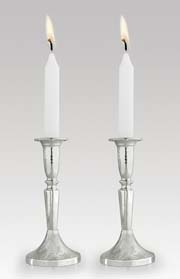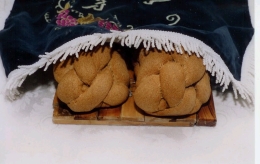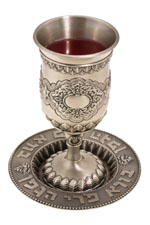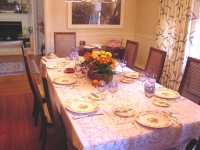Shabbat is the period from twilight on Friday to nightfall on Saturday evening. It is the most precious time of the whole week in the Jewish calendar. Shabbat is a time for peace, harmony, tranquility, community and spirituality that is unmatched on any other day.
Candles
 Candles are very significant in Jewish life and feature on many occasions.
Candles are very significant in Jewish life and feature on many occasions.
Candles are lit on the Friday night leading into Shabbat (Sabbath) as part of Shalom Bayit (harmony in the home), and Oneg Shabbat (Sabbath joy). Before electricity, lighting candles ensured that there was light in the room, that people could see what was in the room and avoid accidents, and that Shabbat would be more enjoyable than if observed in a dark room. The rabbis required people to light candles to increase Oneg Shabbat and Shalom Bayit. They did not just suggest that people use candles but actually required it for a simple reason – without the incentive of it being required by the rabbis, many poor people would have spent the Shabbat in darkness (synagogues used to have funds to help poor congregants afford Shabbat ‘necessities’ such as candles). God “sanctified us by His commandments and commanded us to kindle the Sabbath light.” The candles should be in the room where the Friday night meal is eaten.
The woman of the house is usually the person who lights the candles, unless there is no woman present.
Candles can be lit up to one and a quarter hours before the commencement of Shabbat, but are usually lit 18 minutes before sunset. If need be, candles may be lit during the 18 minutes preceding the sunset.
At least two candles must be lit, to signify shamor (observance) and zachor (remembrance), the two aspects of Shabbat observance which are prescribed by the 4th of the 10 Commandments.
It is permissible and quite common to light more than two candles on Shabbat. Some people light an additional candle for every child and grandchild in the family. Once a certain number of candles have been lit it is customary never to decrease that number.
The procedure for candle-lighting for Ashkenazi Jews is as follows: candles are lit at the appropriate time; the hands are then drawn around the candles towards the face (usually three times, but some people do this up to seven times), and to draw the light into oneself. The eyes are then covered with both hands, and the blessing is recited.
According to Halachah (Jewish law), a blessing is said before an act. In this instance the blessing of the candles initiates the Shabbat, therefore it is forbidden to light them after the blessing. To counteract this, the eyes are covered so that the light is seen as new after the blessing has been said. Interestingly, Sephardi Jews do say the blessing before lighting the candles and consider this permissible.
On Saturday night, Havdalah is made with a Havdalah candle, a cup of wine and fragrant spices, to farewell the Sabbath and begin the new week.
For Jews, the candle will continue to symbolise the spirit of God, the light of the Torah, the conclusion of the Sabbath, and the memory of departed souls.
Challah
 Challah is the traditional plaited bread especially baked for Shabbat and other holidays. Although these days most people buy ready-made challah for Shabbat, some still make their own at home as an additional way of honouring the Shabbat.
Challah is the traditional plaited bread especially baked for Shabbat and other holidays. Although these days most people buy ready-made challah for Shabbat, some still make their own at home as an additional way of honouring the Shabbat.
Challah means ‘dough’, in particular the portion of dough separated from each batch of bread as commanded by the Torah. In the days when the Temple in Jerusalem still stood this portion of separated dough was given to the priests (Kohanim), but this mitzvah has been fulfilled since the destruction of the Temple by removing a portion from the head of the braided dough before it is baked. The piece is then burnt in the oven to symbolise and commemorate sacrifice as well as the destruction of the Temple.

It is only necessary to separate breads made from barley, maize, spelt, wheat or oats. Challah was once considered a rich man’s bread, as it contained white bread which was relatively expensive (everyday bread tended to be made from rye or other grains and was relatively inexpensive). Challah was specifically eaten on Shabbat and holidays as a way of showing that Shabbat and yom tov are special and showing honour to them; this tradition is followed even in modern times.
A piece of challah for the ritual burning can be removed after baking if it has not been done prior. A special blessing is recited upon this separation: “Blessed are You, Lord our God, King of the Universe, who has sanctified us with His commandments and commanded us to separate.”
On Friday Night two challot (the plural of challah) are present on the dinner table. This commemorates the double portion of manna that was received from God on Fridays by the people of Israel in the desert. This allowed the people on Friday to gather enough manna for both Friday and Shabbat as they were not allowed to gather manna on Shabbat.
A blessing is recited before the breaking and eating of the bread, including challah. On Shabbat, the blessing for bread is said immediately after the Kiddush (‘sanctification’ – a passage in which we proclaim the sanctity of Shabbat).
After the bread has been blessed it should be salted, in recognition of the rituals of the Temple sacrifices, and a reflection of Genesis 3:19: “By the sweat of your brow shall you get bread to eat”.
Before the challah is blessed, and during the blessing for the wine, the bread is kept covered by a cloth. This is to shield its ‘sensitive feelings’ (since, were it not Shabbat, the bread would be blessed first), teaching us that we must respect for the feelings of others, even inanimate objects.
Challah is much more than simply plaited bread, as it is eaten on Shabbat and holidays. It is highly symbolic, reminding us of the significance of even the smallest things, and also that there is reason for everything we do.
Wine and Kiddush Cup
 Wine is regarded as particularly sacred and has its own brachah (blessing). Wine sanctifies the Sabbath at its inception (kiddush) and its conclusion (havdalah). The English word ‘wine’ may derive from the Hebrew yayin.
Wine is regarded as particularly sacred and has its own brachah (blessing). Wine sanctifies the Sabbath at its inception (kiddush) and its conclusion (havdalah). The English word ‘wine’ may derive from the Hebrew yayin.
The kiddush cup is a special goblet set aside for the blessing of the wine. If possible, it should be made from silver. The kiddush wine should lull you into a state of Shabbat serenity. It symbolises joy and cheer, and therefore it is fitting to declare the sanctity of the Sabbath over the cup of wine.
Shabbat Attire
On Shabbat we put on our best clothes, dressing as if for an important occasion. This reinforces that Shabbat is a special day and that we do things in a special way on Shabbat in order to honour the day.
The Shabbat Table
 The Shabbat table is seen as an altar and should be covered with a special white cloth, and set with the best china and silver to honour the Shabbat Queen. The colour white symolises spiritual purity and the Shabbat table is compared to an altar; thus it is appropriate that the table is covered with a white tablecloth.
The Shabbat table is seen as an altar and should be covered with a special white cloth, and set with the best china and silver to honour the Shabbat Queen. The colour white symolises spiritual purity and the Shabbat table is compared to an altar; thus it is appropriate that the table is covered with a white tablecloth.
Shabbat food should be the tastiest and best; it is said that Shabbat adds a special seasoning to your food. Foods typically eaten by Ashkenazi Jews on Shabbat include gefilte fish, chicken soup, kugel, challah and cholent.
The eating of fish on Shabbat is interpreted as a symbol of the blessing that the children of Israel would multiply like the stars in the heavens and the sand of the seas (fish are considered to be able to reproduce especially easily). Cholent (stew) is made to enable the Jews to eat warm food on Shabbat, as it is put in the oven late Friday afternoon and remains there at a low heat, sealed, until Shabbat lunch.
Zemirot
Zemirot (Sabbath table hymns) provide the distinguishing characteristics of the Shabbat meal. They are unique because of their unique blending of the holy and the secular, the serious and the playful. As the zemirot are sung, we forget our weekday worries, burdens and sorrows and experience complete mental and physical relaxation. Sometimes, modern songs both in Hebrew and the vernacular supplement the medieval zemirot.

Havdalah Set
Wine is also blessed and drunk, and used to extinguish the havdalah candle. Just as it is customary to begin Shabbat with a cup of wine, so do we end it with wine.
For more detailed information about Havdalah, please see our page Havdalah
Links to External Videos
YouTube: Blessing Children on Friday Night (United Synagogue)
YouTube: Friday Night Kiddush An excellent introduction to the practicalities of making Kiddush on Friday night, complete with the text both in Hebrew and in English transliteration.
YouTube: The Blessing for Washing Hands Before Eating Bread (United Synagogue)
YouTube: Shabbat Songs
YouTube: Grace After Meals – Birkat Hamazon (Benching) (United Synagogue)
YouTube: Havdallah – The End of Shabbat (United Synagogue)


